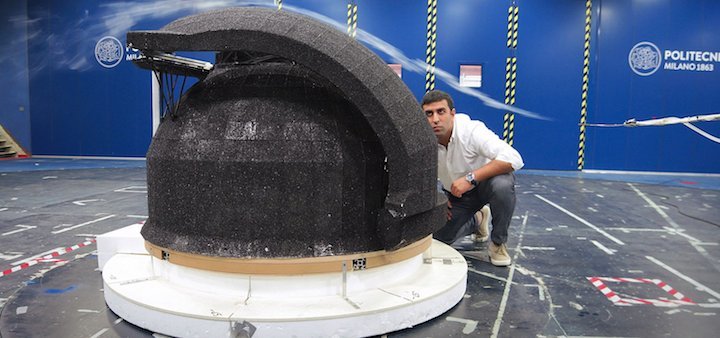21.12.2017
When complete, the ELT dome will stand almost 262 feet (80 meters) high atop Cerro Armazones, a 1.8-mile-high (3 kilometers) mountain in the Sierra Vicuña Mackenna section of the Chilean Coast Range in the Atacama Desert, where the instrument will face rigorous winds. [The Biggest Telescopes on Earth: How They Measure Up]
"These conditions present an engineering challenge, making wind-tunnel tests vital," ESO officials explained in a new video.

Credit: ESO
-
During the tests, a model of the ELT faced blustery conditions in a wind tunnel at the Polytechnic University of Milan in Italy. It was plastered with sensors to measure the structural load it could face.
"The wind-tunnel test is developed to reproduce the conditions that the ELT will face when it's operational," said engineer Luca Ronchi in a blog post, "so, basically, it's about reproducing the dome and telescope on a smaller scale (made of glass-fiber-reinforced plastic), equipping it with sensors, calibrating these sensors, placing the object in the wind tunnel and — according to the established and agreed-upon test program — reproducing the conditions that the ELT will actually face on top of Cerro Armazones."
When complete, the Extremely Large Telescope will use a colossal, 128-foot (39 m) primary mirror, made up of 798 hexagonal mirror segments, to survey the universe like never before.
Quelle: SC
----
Update: 21.12.2023
.

Primary mirror, M1, segments of ESO’s Extremely Large Telescope (ELT) awaiting finishing at Safran Reosc facilities in France. 798 hexagonal segments will work together on the ELT, acting as one giant mirror 39-metres across. Credit: Safran, handout
The first 18 segments of the world’s largest telescope are en route to Chile in preparation for what will be one of astronomy’s biggest constructions on record.
Once complete, the European Southern Observatory’s Extremely Large Telescope (yes, that’s what it’s called) will be the biggest optical and near-infrared ground-based telescope. The project has been in development for nearly 20 years, with construction approved a decade ago.
It is due to come online in 2028.
The assembly of the telescope’s massive mirrors will take place over the next 4 years. This week, the first segments of what will be the main mirror – called ‘M1’ – arrived in Chile.
In total, M1 will consist of 798 mirrors assembled into an almost 40-metre-wide lens.
Before their arrival, these smaller mirrors had their imperfections atomically polished out by French optical systems manufacturer Safran Reosc by ‘sweeping’ their surface with a beam of ions that eat away at the irregularities. Any remnant flaws are no more than 10 nanometres wide – about the size of a biological cell membrane.
The remaining 780 pieces of M1 will be polished and shipped in the coming months, around 4 segments are being prepared each week by Safran Reosc.
The Extremely Large Telescope will be built in the Atacama Desert in the north of Chile, which is one of the darkest skies in the world.
Quelle: COSMOS